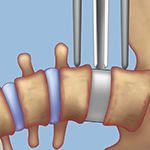The treatment of adult scoliosis is very individualized and based on specific symptoms, degree of curve, where the curve is located on the spine, how quickly the curve is progressing, existence of other medical conditions, and age and overall health of the patient.
Surgery may be recommended when conservative treatments did not work and the spinal deformity is progressing or has caused serious complications. The goal of surgery for scoliosis is to correct the curve, halt its progression, and reduce pain and neurological symptoms. The neurosurgeons and orthopedic surgeons at Och Spine at NewYork-Presbyterian/Weill Cornell Medical Center are often sought out to perform revision surgeries for individuals who have had past surgeries elsewhere with poor outcomes. Our experienced spine surgeons, who have been trained in the most advanced reconstructive surgical techniques, can determine the best treatment for each patient and each situation.
Since spinal deformities vary from patient to patient, no two surgical treatments will be the same, and the medical team will choose specific surgical procedures for the patient depending on the details of the diagnosis. Surgical techniques for scoliosis have come a long way recently with the development of minimal access, minimally invasive techniques, although traditional open surgery may sometimes be necessary. Our spine surgeons have developed expertise in some of the most technically advanced surgeries for scoliosis.

In the XLIF procedure, a neurosurgeon approaches the spine from the side and inserts a spacer to correct curvature.
XLIF (Extreme Lateral Interbody Fusion): This advanced method of minimally invasive surgery approaches the spine from the side, avoiding the major muscles of the back. A spine surgeon makes a small incision in the patient’s side, between the lower ribs and pelvis, and inserts a special surgical instrument just above the disc space. The surgeon removes the damaged disc tissue and inserts a spacer between the vertebrae. The surgical team monitors the position and correct placement of the spacer, sometimes using special screws or a plate on the side of the spine to offer additional stability. Patients typically are walking within a few hours of the XLIF procedure and are then discharged the next day. Most patients are back to work within approximately two weeks. (Download the “About Lateral Access Surgery” brochure here)
Spinal Reconstruction: Every individual’s deformity is different and requires a tailored approach. The goal of any reconstruction is to restore alignment and decompress neural elements. Some patients may fare better with a posterior approach (from the back). Some may best be treated with a two-stage approach, with anterior and posterior surgery. Most patient will require osteotomies or cuts in the bone to increase flexibility of the spine prior to correction.
Minimally invasive spinal fusion surgery fuses the bones of the spine in the lower back together so that there is no longer any motion between them. This reduces spinal pressure, pain, and nerve damage and fixes the deformity. Minimally invasive lumbar fusions do not require the large incision or the muscle retraction typically used in conventional fusions. Patients undergoing this procedure usually have faster recovery times that those having open surgery. A recent advance is the use of a computerized image guidance system for many patients undergoing lumbar fusion. This has the advantage of aiding the surgeon in optimal placement of screws and avoiding injury to delicate nerve tissue.
Navigation: Our neurosurgeons use state-of-the-art navigation and intraoperative CT scans to perform complex reconstructions with added safety and accuracy. Our spine surgeons are some of the leaders in the field of navigation for spinal deformity.
Reviewed by: Kai-Ming Fu
Last reviewed/last updated: August 2021
Illustration by Thom Graves, CMI